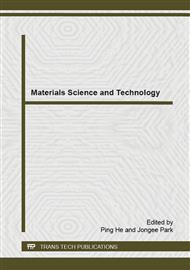p.3
p.9
p.15
p.21
p.26
p.32
p.38
p.42
p.49
High Strength and Ductility in Multi-Directional Forged Wrought Aluminum Alloys
Abstract:
A wrought aluminum alloy 3004 was processed by multi-directional forging (MF), natural aging and artificial aging. The samples possess high strength and high ductility after processing. Grain size in samples was reduced evidently. The strength of samples was enhanced by dispersing ultrafine precipitate particles within the grains, reducing grain-size after MF and aging. The ductility was improved due to reducing the forging stress during aging. Moreover, a dispersing ultrafine precipitate particles widespread within the grains after aging, which helps to accumulate dislocations, increase the dislocation storage capability and resist dislocation slip that lead up to increasing work hardening, the ductility was also enhanced. The tensile strength and ductility of the alloy are 422.4 MPa and 11.95%, respectively.
Info:
Periodical:
Pages:
26-31
Citation:
Online since:
December 2014
Authors:
Keywords:
Price:
Сopyright:
© 2015 Trans Tech Publications Ltd. All Rights Reserved
Share:
Citation:


